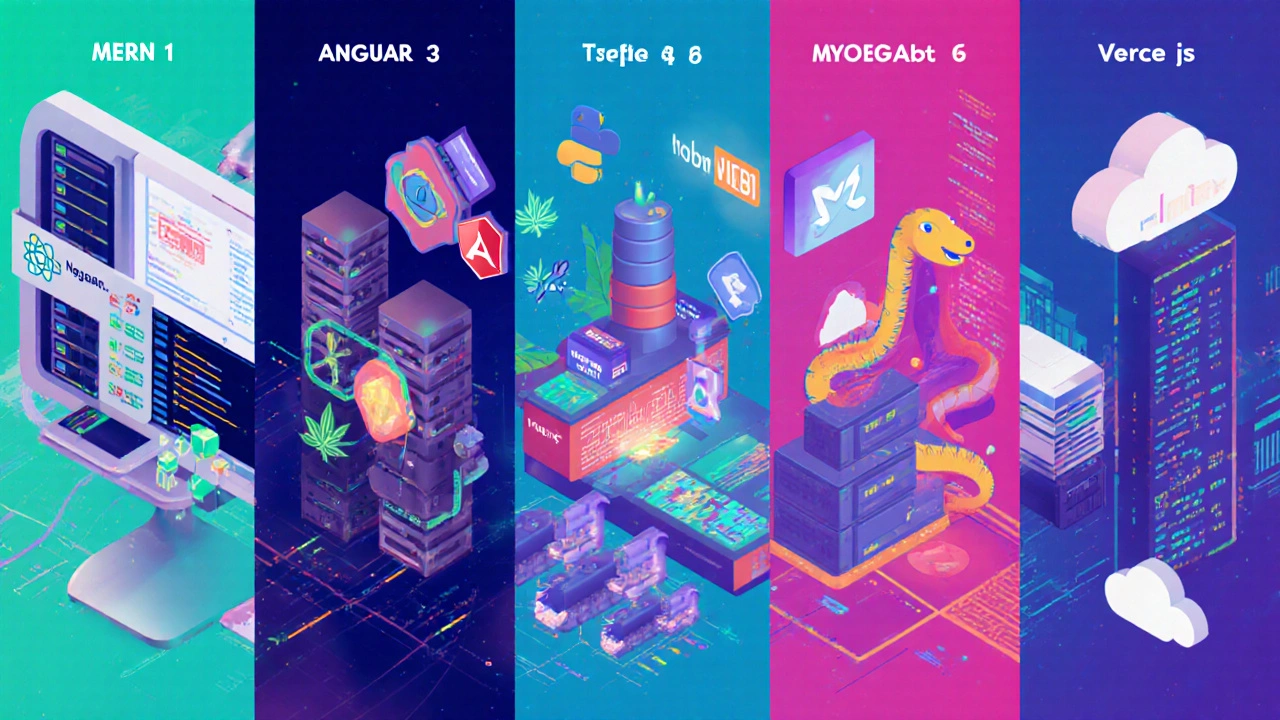Web Development Stack Selector
Select your preferences below to get personalized recommendations for the best web development stack in 2024.
Recommended Stack
Score Breakdown:
Stack Comparison
| Stack | Primary Language | Frontend | Backend | Database |
|---|
Choosing the right Web Development Stack a combination of frontend, backend, database, and tooling technologies that work together to build modern web applications can feel like picking a flavor at an ice‑cream shop - there are too many tasty options and you don’t want to waste time on a choice that won’t serve your goals. In 2024 the landscape has shifted: server‑less functions are common, TypeScript has become the default for new projects, and cloud‑native deployments dominate. This guide walks you through the decision‑making process, highlights the hottest stacks, and gives you a concrete learning roadmap so you can start building real‑world apps without getting lost in theory.
How to Pick the Right Stack for Your Goals
Before you dive into any specific technologies, ask yourself three practical questions:
- Career path: Do you aim for a front‑end specialist role, a full‑stack engineer position, or a backend‑focused backend‑as‑a‑service career?
- Project type: Are you building a single‑page application, a data‑heavy dashboard, an e‑commerce site, or a real‑time collaboration tool?
- Community & job market: Which technologies are hiring actively in your region or remote market?
Answering these gives you a matrix of priorities - language preference, ecosystem maturity, hosting costs, and learning curve. Keep the matrix simple: rate each factor from 1 (low) to 5 (high) and sum the scores for each stack you consider. The highest total points to the stack that aligns best with your situation.
Top Stacks to Learn in 2024
Below are the six most in‑demand stacks based on job postings, community activity on GitHub, and surveys from major tech outlets in early 2024.
1. MERN (MongoDB, Express, React, Node.js)
The MERN stack remains a go‑to for JavaScript lovers who want a unified language across the entire application. React (marked up later) handles the UI, while Node.js runs the server, and Express provides a lightweight routing layer. MongoDB’s flexible schema works well with rapid prototyping.
Key reasons to learn MERN:
- Full JavaScript stack - reduces context switching.
- Huge job market; many startups list MERN as a required skill.
- Strong community tutorials and boilerplate generators (e.g., create‑react‑app + express generator).
2. MEAN (MongoDB, Express, Angular, Node.js)
If enterprise‑grade tooling and TypeScript‑first development appeal to you, the MEAN stack is worth a look. Angular (marked up later) brings a powerful CLI, built‑in RxJS for reactive programming, and a structured architecture that many large companies favor.
Benefits:
- Opinionated framework - fewer decisions about project structure.
- Comprehensive testing support out of the box.
- Microsoft and Google back Angular, ensuring long‑term stability.
3. LAMP (Linux, Apache, MySQL, PHP)
Even after two decades, LAMP powers a massive portion of the web, especially content‑heavy sites and legacy applications. PHP (marked up later) has modernized with versions 8.x, offering just‑in‑time compilation and type declarations.
Why LAMP still matters:
- Cheap hosting - most shared hosts support LAMP out of the box.
- WordPress, Drupal, and Joomla are built on it, guaranteeing steady demand for maintenance roles.
- Easy to spin up a full stack on a local VM or Docker container.
4. Django+React (Python + JavaScript)
Django (marked up later) is a high‑level Python framework that ships with an admin panel, ORM, and security features. Pairing it with React on the front‑end gives you a powerful separation of concerns: Python handles business logic, React handles UI.
Advantages:
- Python’s readability accelerates onboarding for new developers.
- Strong ecosystem for data science, making it ideal for AI‑powered web apps.
- Built‑in protection against common security pitfalls.
5. Ruby on Rails (Ruby)
Rails (marked up later) embraces convention over configuration, letting you scaffold a full CRUD app in minutes. While its market share has narrowed, many high‑traffic SaaS products still rely on Rails for rapid iteration.
Key points:
- Rich gem library - most features have ready‑made extensions.
- Excellent testing tools (RSpec, Capybara).
- Active community that values developer happiness.
6. Serverless Full‑Stack (Next.js, Vercel, AWS Lambda)
Serverless architectures remove the need to manage servers entirely. Next.js (marked up later) combines React with file‑based routing and can export static pages or run server‑side code on Vercel’s edge network. Backend functions live as AWS Lambda, Google Cloud Functions, or Azure Functions.
Why go serverless?
- Pay‑as‑you‑go pricing - ideal for startups.
- Automatic scaling without manual load balancers.
- Reduced DevOps overhead; focus on code, not infrastructure.

Comparison Table
| Stack | Primary Language(s) | Frontend Framework | Backend Runtime | Database | Ideal Projects |
|---|---|---|---|---|---|
| MERN | JavaScript / TypeScript | React | Node.js (Express) | MongoDB | SPAs, real‑time apps |
| MEAN | TypeScript | Angular | Node.js (Express) | MongoDB | Enterprise dashboards |
| LAMP | PHP | None (server‑rendered) | Apache | MySQL | CMS, blogs, e‑commerce |
| Django+React | Python / JavaScript | React | Django (WSGI/ASGI) | PostgreSQL | Data‑driven web apps |
| Ruby on Rails | Ruby | None (Rails view layer) | Rails (Puma) | PostgreSQL / SQLite | Start‑ups, MVPs |
| Serverless (Next.js) | JavaScript / TypeScript | React (Next.js) | Vercel Edge / AWS Lambda | Any (managed services) | Rapid launches, SEO‑focused sites |
Learning Roadmap Checklist
Pick a stack and follow this step‑by‑step checklist. Tick each item as you complete it.
- Set up a development environment (VS Code, Docker, Git).
- Learn the core language syntax (JavaScript, Python, PHP, Ruby).
- Complete a beginner tutorial that builds a "Hello World" app for the chosen stack.
- Explore the official docs of the frontend framework (React, Angular, Vue) - focus on component structure and state management.
- Implement CRUD operations using the backend (Express, Django, Rails) and connect to the database.
- Deploy a test version to a free tier (Vercel, Netlify, Heroku, Railway).
- Integrate a version‑control workflow: feature branches, pull requests, CI (GitHub Actions).
- Add authentication (JWT, OAuth) and role‑based access.
- Write unit tests for at least one backend endpoint and one frontend component.
- Refactor for performance: lazy‑load modules, enable caching, use a CDN.
When you finish, you should have a live, full‑stack project you can showcase on GitHub or a personal portfolio.
Common Pitfalls and Pro Tips
Pitfall: Jumping straight into advanced topics like GraphQL before mastering REST basics. Tip: Build a simple REST API first; the concepts of resources, status codes, and authentication translate directly to GraphQL.
Pitfall: Ignoring TypeScript in a JavaScript‑heavy stack. Tip: Start each new project with tsconfig.json from day one - the added type safety saves debugging time later.
Pitfall: Over‑engineering architecture for a hobby project. Tip: Keep the folder structure flat, use the framework’s CLI generators, and add complexity only when the app’s scope truly expands.
Pitfall: Forgetting about security best practices (SQL injection, XSS). Tip: Always use ORM parameterization, enable CSP headers, and run a static analysis tool like ESLint or Bandit.
What Employers Look For in 2024
Hiring managers increasingly value demonstrable projects over certificates. A portfolio that shows:
- End‑to‑end deployment on a cloud platform.
- Integration of a modern UI library (React, Angular, or Vue).
- Testing coverage above 70%.
- Use of CI/CD pipelines.
- Clear documentation (README, API spec).
Pair that with a concise LinkedIn summary that mentions the specific stack you mastered (e.g., "Full‑stack MERN developer with production experience on Vercel") and you’ll stand out in the crowded job market.
Frequently Asked Questions
Which stack is best for a complete beginner?
For absolute beginners, the MERN stack is often recommended because JavaScript is used everywhere - in the browser, on the server, and for database queries. Starting with React gives a gentle introduction to component‑based UI, while Node.js and Express keep the backend simple.
Is learning Python for web development still relevant?
Absolutely. Python powers Django and Flask, both of which are favored for data‑intensive applications, rapid prototyping, and integration with machine‑learning libraries. Companies building analytics dashboards or AI‑enhanced platforms still list Python‑based stacks as a top skill.
Should I invest time in learning serverless now?
Serverless is a good investment if you want to avoid managing servers and focus on code. Services like Vercel’s edge network work seamlessly with Next.js, letting you deploy updates in seconds. However, for apps that need long‑running background jobs, a traditional VM or container might still be a better fit.
How important is TypeScript in 2024?
TypeScript has become the default for new JavaScript projects because it catches errors during development, improves IDE autocomplete, and scales better in larger codebases. Most senior roles list TypeScript experience as a requirement, so learning it early gives you a clear edge.
Can I switch stacks later without starting from scratch?
Yes. Core concepts like HTTP, REST, authentication, and MVC patterns stay the same across stacks. When you move from MERN to Django+React, you’ll keep the React front‑end and just replace the backend language. The transition mainly involves learning the new server‑side language’s syntax and framework conventions.
Whether you aim to land a junior dev job, launch a SaaS startup, or simply add a marketable skill to your résumé, picking the right web development stack and following a structured learning plan will accelerate your progress. Start small, build real projects, and keep an eye on emerging tools - that’s the formula that keeps developers relevant year after year.
